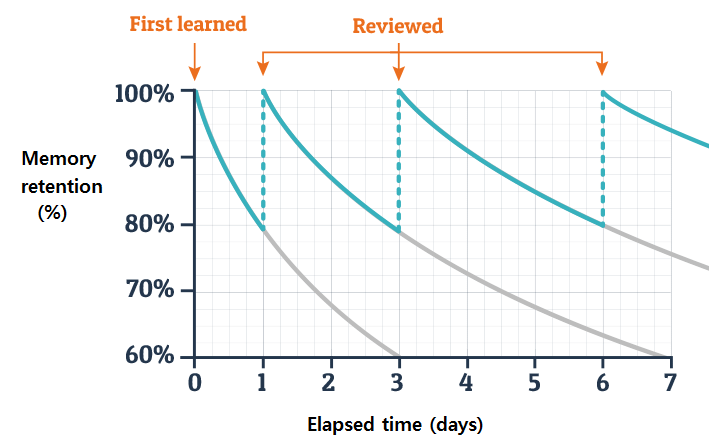
Congrats, you invested in your team and implemented a sales training program. Now what? Training doesn’t end when the course does. Instead, to maximise results, you have to plan out how you’re going to reinforce the new skills post training.
While today’s in-person, VILT, and eLearning solutions are invaluable and effective tools for teaching and engaging remote learners – if you want to see tangible results from your return on investment, you must build opportunities to reinforce sales training. Ready to finally maximise your ROI? Continue reading to learn how to reinforce sales training in the workplace.
Also read:
- How To Choose The Best Sales Training Company: A Step-By-Step Guide
- Is VR Training in the Workplace The Future Of Upskilling Sales Teams?
- Hiring Salespeople: How To Find, Hire & Retain Top Performing Reps
What is training reinforcement?
Training reinforcement is the process of actively helping your employees to retain knowledge to help support new behavioural changes and effective on-the-job application. The idea of training reinforcement is not to teach learners anything new but to support them in remembering and applying what they have already learnt. By doing so, employees translate new knowledge into new skills ready to be put into action.
Why do I need to reinforce employee training?
Learning is not a one-off event. It’s actually more of a four-step process that requires attention and nurturing to be effective. The learning process usually looks something like this:
Step 1. Learn. (New information)
Step 2. Encode it. (Transferring the information from short-term to long-term memory)
Step 3. Recall it. (Retrieve information from short-term or long-term memory)
Step 4. Apply it. (Commit new knowledge to long-term memory)
Therefore, when you only address the first step in the learning process but neglect to follow through on training reinforcement, you’re wasting time and money on training that employees can’t recall and use on the job.
How much do employees forget after training?
Employees are likely to learn something new and immediately forget it. According to research, learners forget approximately 50% of training within only one hour of training, with this figure increasing to 70% at a mere 24 hours! Within 30 days, the amount forgotten increases to 90%.
Developed by German psychologist Hermann Ebbinghaus in the 1880s, the Forgetting Curve below demonstrates how quickly memory retention drops after learning new information. Ultimately, to negate the effects of the forgetting curve in your sales training, learning how to reinforce training is key to maximising ROI.

How To Reinforce Sales Training
Sales training reinforcement is crucial if you want sales reps to transform classroom training and knowledge into real-world application skills that benefit your bottom line. To support your sales reps and managers permanently retain essential sales skills and maximise your training investment, use the following tips as a guide to creating an overall reinforcement strategy:
1. Create a strategic training reinforcement program
If it takes, on average, 66 days (around two months) for a new skill to become a habit, you need a consistent training cadence to help reinforce learners’ abilities to make learned skills their new normal. The length and structure of training reinforcement cadences vary from business to business, but many choose to apply spaced learning techniques to strengthen memorability.
You can start to apply this technique by scheduling periodic mini-training sessions, where communication is either synchronous or asynchronous.
Many choose to reinforce sales training with a blended learning solution, a combination of online resources and real-time meetings. However they’re conducted, the key is to use continuous training as a way to give learners more touchpoints with the content and create chances for active recall.
2. Encourage Microlearning
In this busy world, every piece of content we consume is becoming quicker and shorter, accommodating all learning types and lifestyles. That’s why Microlearning is quickly becoming a go-to when it comes to reinforcing sales training. Microlearning consists of “bite-sized” learning experiences such as “tip” videos under 5 minutes, on-the-job coaching, and longer e-learning courses that include a series of videos. Microlearning is effective, affordable, and flexible; it’s also incredibly agile and allows your team to be on top of things that aren’t working and things that are – so your processes will constantly improve.
Also read: E-Learning and Its Role in Today’s Sales Teams
3. End training with an action plan
Ensure there is no early retention loss by dedicating time at the end of each training session for learners to document how they’ll apply what they’ve learned back on the job. This method allows sales reps to affirm goals and commitments, which makes their learning more memorable, but it should also include specific and measurable goals that they can quickly reference back on the job.
4. Create a supportive workplace culture
It’s difficult to convince the brain that information is vital to the job at hand if it’s unrelated to your goals and purpose – which is why creating a supportive company culture is crucial to reinforce training. Achieving this includes approaching it as a team by adopting key vocabulary, and processes sales reps bring back from training in your daily internal communications and meetings. You can also provide a space for discussions to help sales reps coach fellow learners and include goals from their training in your quarterly and annual reviews. Read on to discover our conversation with Steve Simpson about the impact of company culture on performance.
5. Practice regular sales-role playing
Training doesn’t always prepare learners for real-world application. Sales reps might also have circumstance-specific questions that an E-learning module or tip videos can’t answer. That’s where sales role-playing as a reinforcement tool comes into effect – it also gives sales managers, leaders and coaches the opportunity to offer much-needed feedback.

Outside of the apparent benefits, this type of hands-on training also helps sales reps prepare for customer interactions, particularly challenging ones, alongside creating a sense of familiarity with the situation while providing a team-building experience. Discover our 4 effective exercises for using role-playing as a sales training tool.
6. Try VR learning simulations
To maximise retention of new skills, learners need to practice new techniques they’re taught. As stated above, this is often done through role-playing. But, by incorporating VR simulations into your training reinforcement strategy, learners can use a virtual environment to practice. VR role-playing simulations can either be custom made for your company or choose pre-set up vr scenarios which include live sales pitches in a boardroom, 60-second virtual elevator pitches, and even virtual reality exhibition scenarios.
7. Host regular sales coaching sessions
It’s crucial to host regular sales coaching sessions with an expert sales coach who understands your sales strategy and business objectives. Sales coaches act as neutral figures who guide your sales team in applying the processes they have been trained in and ensuring reinforcement is successful. Our recommended structure for sales coaching sessions that reinforce learning is:
- Schedule group coaching to debrief with the training participants.
- Keep it focused. Each coaching session focuses on one training topic
- Ask about improvements. Ask questions like “What’s better since the training?”
- Goal-setting and commitment. Ask what they will change next
- Schedule the next session.
8. Send helpful reminder reinforcement emails
Creating a series of reminder emails is an excellent method of keeping your learners’ memory from fading. By sending emails that complement learners’ training at regular intervals, you’ll help trigger their memory of key concepts – ready to go into their long term memory. These helpful reminder emails should include content like:
- Motivational quotes
- Case studies of skills in action (Videos, text, audio)
- Summaries of key concepts
- Articles, blog posts and social posts
- Cheat-Sheets
- Infographics
- Podcasts
9. Measure results with Kirkpatrick’s 4 Level Framework
While the above are excellent methods of helping to reinforce sales training. How do you know sales training has worked and will bring a profitable ROI? You can use Kirkpatrick’s 4 Level Framework. Since the 1950s, this framework has given us a way to start an objective evaluation of our training programs. By evaluating each level of the training, it will reveal a different facet of the training – check it out below:
Kirkpatrick’s 4 Level Framework
- Level 1: Determine how trainees feel about the program.
- Level 2: Determine how much the trainees learn in the form of increased knowledge and understanding.
- Level 3: Measure the changes in on-job-behaviour of the trainees.
- Level 4: Determine the effects of behavioural changes on objective criteria such as production, turnover, absenteeism and waste.
Sales Training Reinforcement Q&A
Didn’t find the answer you were looking for on how to reinforce sales training? Check out our helpful Q&A below:
Q: What kind of content should I use to reinforce training?
To reinforce learning use a combination of the bellow methods:
- Whitepapers
- Micro videos
- Articles
- Podcasts
- Infographics
Q: How can I test learners on knowledge of new skills?
Training reinforcement isn’t about memorising information but instead extending your employees’ learning process. That’s why you should use content that tests them on what they’ve already learnt to help their brain apply that information in new ways. Types of post-training reinforcement content could include:
- Thought questions
- Multiple-choice questions
- Short answer questions
- Poll questions
- Short videos
- On the job behaviour
Q: How much does it cost if we skip training reinforcement?
Frankly, when you don’t provide reinforcement follow-ups to your sales training, you lose approximately 50-90% of your resources on learning programs. Any knowledge your learners did retain will be lost within 30 days of training if not appropriately reinforced, meaning that if you choose to skip out on it – you’re just wasting time and money.
How SOCO reinforces learning
Here at SOCO, we don’t believe in 1-off training, because frankly we know it doesn’t work. Instead we focus on implementing a system that incorporates post training reinforcement that includes microlearning, coaching, e-learning and evaluating the changes to on the job behaviour.
Upskill your most valuable resource
Nothing is more demotivating than not having the skills to excel in one’s role. By providing corporate training for your personnel, you can develop their weaknesses into strengths. Ultimately, allowing for increased productivity, motivation and adoption of new technologies while reducing employee turnover.
We’re the leading corporate training provider – and for a good reason. Our diverse range of training courses are interactive, fun, memorable and most importantly, effective.


